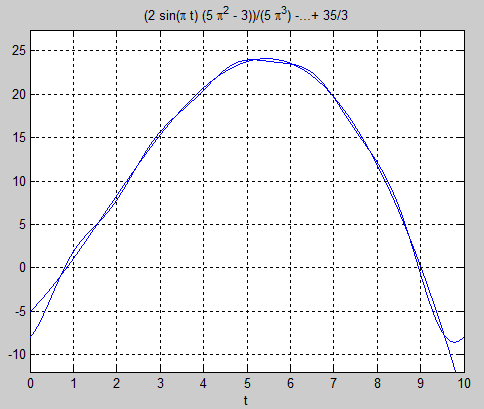David Valencia ● January 31, 2011
● Coded in
Matlab This program can compute an approximate function to one the user describes in terms of t, and plots both functions to see the differences between them.
A simple example:

The command window looks like:
### FOURIER TRIGONOMETRICAL SERIES###
Specify the range (t1,t2) for the approximation:
t1= 0
t2= 10
Is there a repeating patterin in this range? (Y/N): N
The approximation will be generated in a trigonometrical series:
f(t)=a0+a1*cos(omega0*t)+a2*cos(2*omega0*t)+...+b1*sen(omega0*t)+b2*sen(2*omega0*t)
Until what coefficient ak,bk should I compute? (positive integer) n= 5
Is the function defined by parts? (Y/N): N
Write the function in terms of t
f(t)= 5*t+1.4*t^2-0.3*t^3+0.01*t^4-5
The resulting coeficcients are:
a0 =
35/3
a =
[ -(10*(11*pi^2 + 30))/pi^4, -(5*(22*pi^2 + 15))/(4*pi^4), -(10*(33*pi^2 + 10))/(27*pi^4), -(5*(88*pi^2 + 15))/(64*pi^4), -(2*(55*pi^2 + 6))/(25*pi^4)]
b =
[ (10*(pi^2 - 15))/pi^3, (5*(4*pi^2 - 15))/(4*pi^3), (10*(3*pi^2 - 5))/(9*pi^3), (5*(16*pi^2 - 15))/(32*pi^3), (2*(5*pi^2 - 3))/(5*pi^3)]
Do you wish to plot the graph of f(t) against the approximate series? (Y/N): Y
END OF PROGRAM>
%Trigonometric Fourier Series Approximation
%José David Valencia Pesqueira - UPIITA-IPN
%As posted for Dsprelated.com
close all; clear all; clc;
syms t k;
fprintf('\n ### FOURIER TRIGONOMETRICAL SERIES###');
fprintf('\nSpecify the range (t1,t2) for the approximation:\n');
t1=input('t1= ');
t2=input('t2= ');
% Getting the period
fprintf('\nIs there a repeating patterin in this range? (Y/N): ');
resp1=input('','s');
switch resp1
case 'Y'
fprintf('\nWhat is the period for the function?\n');
T=input('T= ');
omega0=(2*pi)/T;
case 'N'
T=t2-t1;
omega0=(2*pi)/T;
otherwise
fprintf('\nInvalid Option');
fprintf('\nEnd of program>>>');
return
end
fprintf('\nThe approximation will be generated in a trigonometrical series: \n\n');
fprintf('f(t)=a0+a1*cos(omega0*t)+a2*cos(2*omega0*t)+...+b1*sen(omega0*t)+b2*sen(2*omega0*t)');
fprintf('\n\nUntil what coefficient ak,bk should I compute? (positive integer) n= ');
n=input('');
if n<=0
fprintf('Invalid n');
fprintf('\nProgram Stop >>>');
return
end
fprintf('\nIs the function defined by parts? (Y/N): ');
resp1=input('','s');
switch resp1
case 'N'
fprintf('\nWrite the function in terms of t\nf(t)= ');
f=input('');
faprox=0;
a0=(1/T)*int(f,t,t1,(t1+T));
faprox=a0;
for k=1:n
a(k)=(2/T)*int((f*cos(k*omega0*t)),t,t1,(t1+T));
faprox=faprox+a(k)*cos(k*omega0*t);
end
for k=1:n
b(k)=(2/T)*int((f*sin(k*omega0*t)),t,t1,(t1+T));
faprox=faprox+b(k)*sin(k*omega0*t);
end
% If the function is defined in many parts
case 'Y'
fprintf('\nHow many ranges do you want to define (positive integer): ');
numinterv=input('');
numinterv=round(numinterv);
for k=1:numinterv
fprintf('\n## Range #%d definition',k);
fprintf('\n Write the range in the form of t(%d)<t<t(%d) : ',k-1,k);
fprintf('\nt(%d)= ',k-1);
a(k,1)=input(''); %Initial limits vector
fprintf('\nt(%d)= ',k);
a(k,2)=input(''); %Final limit vector
fprintf('\nThe range # %d has a start in %d and ends in %d',k,a(k),a(k+1));
fprintf('\nPlease define f(t) for the %d th interval:\nf(t)= ',k);
ft(k)=input('');
fprintf('\nEnd of definition of the function f%d',k);
end
faprox=0;
a0=0
for j=1:numinterv
a0=a0+(1/T)*int(ft(j),t,a(j,1),a(j,2));
end
faprox=a0;
% ak coefficient
ak=0;
for j=1:numinterv
acumulador=(2/T)*int((f(j)*cos(k*omega0*t)),t,a(j,1),a(j,2));
ak=ak+acumulador;
end
return
fprintf('\n## End of Debug Execution');
return
otherwise
fprintf('\nEND OF PROGRAM>>');
return
end
%% Salida de datos
fprintf('\nThe resulting coeficcients are: ');
a0
a
b
fprintf('\n Do you wish to plot the graph of f(t) against the approximate series? (Y/N): ');
resp1=input('','s');
if resp1=='Y'
ezplot(f,[t1,t2]);
hold on
ezplot(faprox,[t1,t2]);
grid;
end
fprintf('\nEND OF PROGRAM');


















